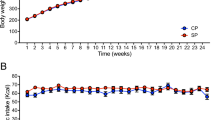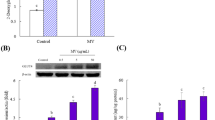Abstract
Whole grain comprises starchy endosperm, germ, and bran tissues, which contain fibers, minerals, vitamins, and several phytochemicals. Whole grain cereal (WGC)-based food products supply beneficial nutrients (essential for health care) and macronutrients (essential for body maintenance and support). The present study investigated the inhibitory effect of WGC on obesity-induced muscle atrophy in obese C57BL/6N mice. WGC attenuated the body weight gain, fat pad mass, adipocyte size, food efficiency ratio, serum lipid profile, and non-alcoholic fatty liver. Furthermore, WGC increased muscle mass and muscle strength by activating the phosphatidylinositol 3-kinase/protein kinase B pathway. Accordingly, WGC up-regulated the expression of factors that regulate muscle hypertrophy and myogenesis, whereas it down-regulated the atrophy-related factors. Overall, these results demonstrate that WGC effectively attenuates obesity-induced muscle atrophy as well as overall obesity, suggesting that WGC can be used as a functional food.



Similar content being viewed by others
References
Ho JN, Son ME, Lim WC, Lim ST, Cho HY. Germinated brown rice extract inhibits adipogenesis through the down-regulation of adipogenic genes in 3T3-L1 adipocytes. Plant Foods Hum. Nutr. 68: 274–278 (2013).
Ho JN, Choi JW, Lim WC, Kim MK, Lee IY, Cho HY. Kefir inhibits 3T3-L1 adipocyte differentiation through down-regulation of adipogenic transcription factor expression. J. Sci. Food Agric. 93: 485–490 (2013).
Ahn J, Lee H, Kim S, Ha T. Curcumin-induced suppression of adipogenic differentiation is accompanied by activation of Wnt/β-catenin signaling. Am. J. Physiol. Cell Physiol. 298: C1510–C1516 (2010).
Le NH, Kim CS, Park T, Park JH, Sung MK, Lee DG, Hong SM, Choe SY, Goto T, Kawada T, Yu R. Quercetin protects against obesity-induced skeletal muscle inflammation and atrophy. Mediators Inflamm. 2014: 834294 (2014).
Pompeani N, Rybalka E, Latchman H, Murphy RM, Croft K, Hayes A. Skeletal muscle atrophy in sedentary Zucker obese rats is not caused by calpain-mediated muscle damage or lipid peroxidation induced by oxidative stress. J. Negat. Results Biomed. 13: 19 (2014).
Wannamethee SG, Atkins JL. Muscle loss and obesity: the health implications of sarcopenia and sarcopenic obesity. Proc. Nutr. Soc. 74: 405–412 (2015).
Sishi B, Loos B, Ellis B, Smith W, du Toit EF, Engelbrecht AM. Diet-induced obesity alters signalling pathways and induces atrophy and apoptosis in skeletal muscle in a prediabetic rat model. Exp. Physiol. 96: 179–193 (2011).
Wang DT, Lu L, Shi Y, Geng ZB, Yin Y, Wang M, Wei LB. Supplementation of ketoacids contributes to the up-regulation of the Wnt7a/Akt/p70S6K pathway and the down-regulation of apoptotic and ubiquitin-proteasome systems in the muscle of 5/6 nephrectomised rats. Br. J. Nutr. 111: 1536–1548 (2014).
Ge Y, Chen J. Mammalian target of rapamycin (mTOR) signaling network in skeletal myogenesis. J. Biol. Chem. 287: 43928–43935 (2012).
Chung SI, Kim TH, Rico CW, Kang MY. Effect of instant cooked giant embryonic rice on body fat weight and plasma lipid profile in high fat-fed mice. Nutrients 6: 2266–2278 (2014).
Borneo R, Leon AE. Whole grain cereals: functional components and health benefits. Food Funct. 3: 110–119 (2012).
Shin SH, Song JL, Park MG, Park MH, Hwang SJ, Park KY. Effects of natural raw meal (NRM) on high-fat diet and dextran sulfate sodium (DSS)-induced ulcerative colitis in C57BL/6 J mice. Nutr. Res. Pract. 9: 619–627 (2015).
Kim MB, Song Y, Kim C, Hwang JK. Kirenol inhibits adipogenesis through activation of the Wnt/β-catenin signaling pathway in 3T3-L1 adipocytes. Biochem. Biophys. Res. Commun. 445: 433–438 (2014).
Schaffer-Lequart C, Lehmann U, Ross AB, Roger O, Eldridge AL, Ananta E, Bietry MF, King LR, Moroni A, Srichuwong S. Whole grain in foods: current use, challenges and the way forward. Crit. Rev. Food Sci. Nut. 57: 1562–1568 (2017).
Chen Y, Ross AB, Åman P, Kamal-Eldin A. Alkylresorcinols as markers of whole grain wheat and rye in cereal products. J. Agric. Food Chem. 52: 8242–8246 (2004).
Koh-Banerjee P, Franz M, Sampson L, Liu S, Jacobs DR, Spiegelman D, Willett W, Rimm E. Changes in whole-grain, bran, and cereal fiber consumption in relation to 8-y weight gain among men. Am. J. Clin. Nutr. 80: 1237–1245 (2004).
Bhandari U, Chaudhari HS, Bisnoi AN, Kumar V, Khanna G, Javed K. Anti-obesity effect of standardized ethanol extract of Embelia ribes in murine model of high fat diet-induced obesity. PharmaNutrition 1: 50–57 (2013).
Davaatseren M, Hur HJ, Yang HJ, Hwang JT, Park JH, Kim H-J, Kim MJ, Kwon DY, Sung MJ. Taraxacum official (dandelion) leaf extract alleviates high-fat diet-induced nonalcoholic fatty liver. Food Chem. Toxicol. 58: 30–36 (2013).
Cho SS, Qi L, Fahey GC, Klurfeld DM. Consumption of cereal fiber, mixtures of whole grains and bran, and whole grains and risk reduction in type 2 diabetes, obesity, and cardiovascular disease. Am. J. Clin. Nutr. 98: 594–619 (2013).
Seo CR, Yi B, Oh S, Kwon SM, Kim S, Song NJ, Cho JY, Park KM, Ahn JY, Hong JW. Aqueous extracts of hulled barley containing coumaric acid and ferulic acid inhibit adipogenesis in vitro and obesity in vivo. J. Funct. Foods 12: 208–218 (2015).
Choi JS, Kim H, Jung MH, Hong S, Song J. Consumption of barley β-glucan ameliorates fatty liver and insulin resistance in mice fed a high-fat diet. Mol. Nutr. Food Res. 54: 1004–1013 (2010).
Kozuka C, Yabiku K, Sunagawa S, Ueda R, Taira S, Ohshiro H, Ikema T, Yamakawa K, Higa M, Tanaka H, Takayama C, Matsushita M, Oyadomari S, Shimabukuro M, Masuzaki H. Brown rice and its component, gamma-oryzanol, attenuate the preference for high-fat diet by decreasing hypothalamic endoplasmic reticulum stress in mice. Diabetes 61: 3084–3093 (2012).
Kozuka C, Yabiku K, Takayama C, Matsushita M, Shimabukuro M, Masuzaki H. Natural food science based novel approach toward prevention and treatment of obesity and type 2 diabetes: recent studies on brown rice and γ-oryzanol. Obes. Res. Clin. Pract. 7: e165–e172 (2013).
Ho JN, Son ME, Lim WC, Lim ST, Cho HY. Anti-obesity effects of germinated brown rice extract through down-regulation of lipogenic genes in high fat diet-induced obese mice. Biosci. Biotechnol. Biochem. 76: 1068–1074 (2012).
Szcześniak K, Ciecierska A, Ostaszewski P, Sadkowski T. Transcriptomic profile adaptations following exposure of equine satellite cells to nutriactive phytochemical gamma-oryzanol. Genes Nutr. 11: 5 (2016).
Cohen S, Nathan JA, Goldberg AL. Muscle wasting in disease: molecular mechanisms and promising therapies. Nat. Rev. Drug Discov. 14: 58–74 (2015).
Jeong JW, Shim JJ, Choi ID, Kim SH, Ra J, Ku HK, Lee DE, Kim TY, Jeung W, Lee JH. Apple pomace extract improves endurance in exercise performance by increasing strength and weight of skeletal muscle. J. Med. Food 18: 1380–1386 (2015).
Hornberger TA. Mechanotransduction and the regulation of mTORC1 signaling in skeletal muscle. Int. J. Biochem. Cell Biol. 43: 1267–1276 (2011).
Zanou N, Gailly P. Skeletal muscle hypertrophy and regeneration: interplay between the myogenic regulatory factors (MRFs) and insulin-like growth factors (IGFs) pathways. Cell Mol. Life Sci. 70: 4117–4130 (2013).
Acknowledgements
This work was supported by Korea Institute of Planning and Evaluation for Technology in Food, Agriculture, Forestry, and Fisheries (IPET) through High Value-added Food Technology Development Program, funded by Ministry of Agriculture, Food, and Rural Affairs (MAFRA) (315071-03).
Author information
Authors and Affiliations
Corresponding author
Ethics declarations
Conflict of interest
The authors declare no conflict of interest.
Rights and permissions
About this article
Cite this article
Lee, S., Kim, MB., Kim, C. et al. Whole grain cereal attenuates obesity-induced muscle atrophy by activating the PI3K/Akt pathway in obese C57BL/6N mice. Food Sci Biotechnol 27, 159–168 (2018). https://doi.org/10.1007/s10068-017-0277-x
Received:
Revised:
Accepted:
Published:
Issue Date:
DOI: https://doi.org/10.1007/s10068-017-0277-x




